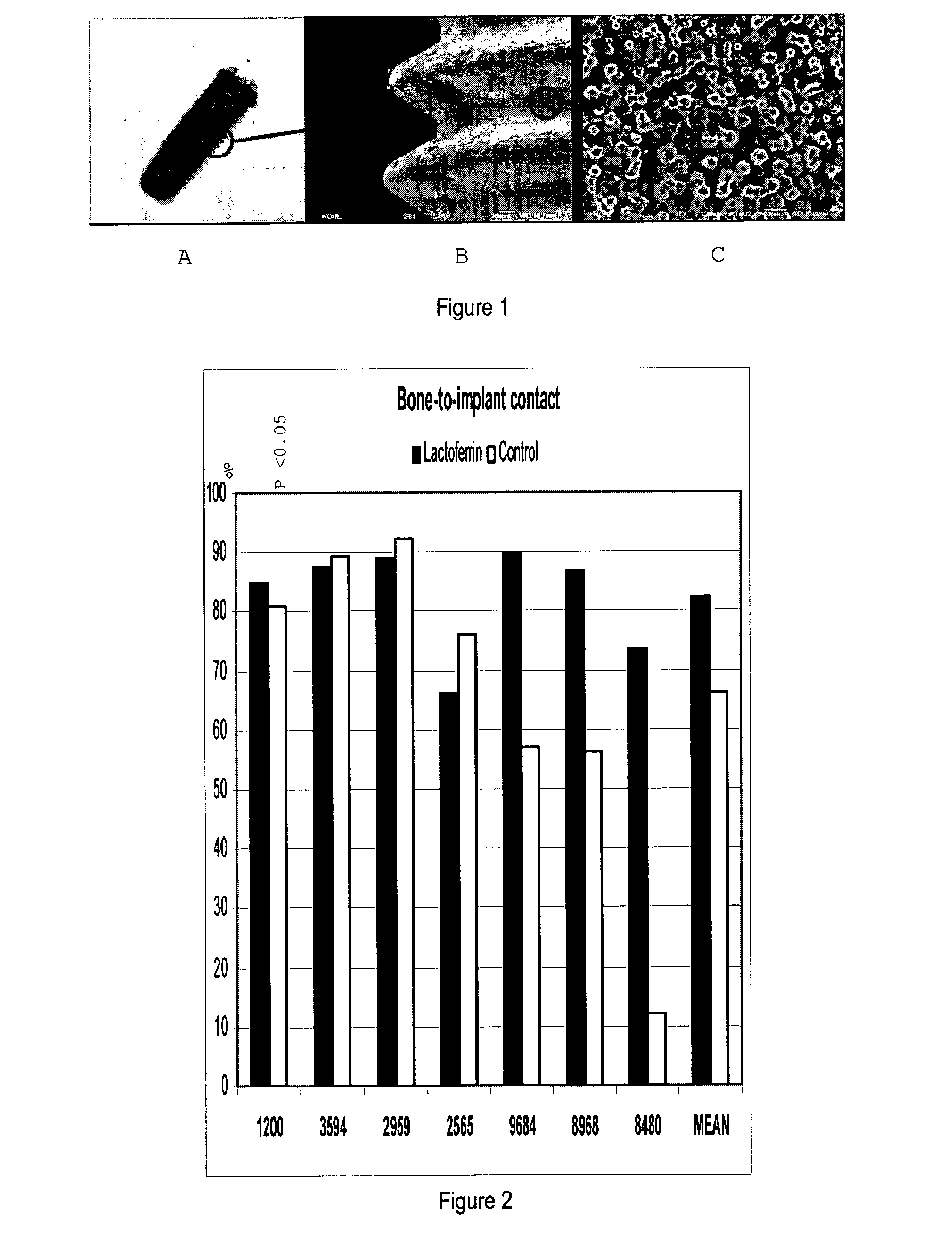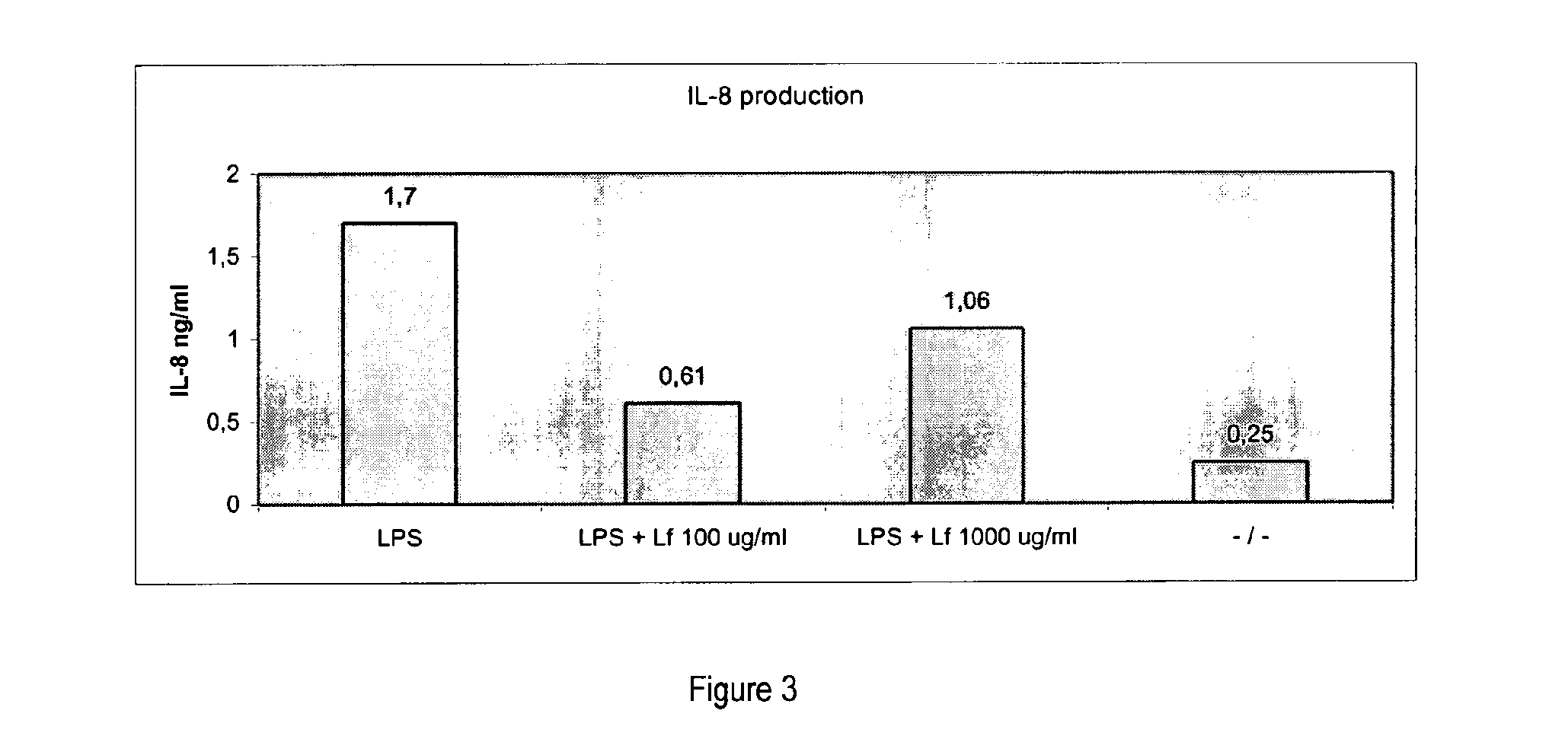Bone implant application
a bone implant and implant technology, applied in the field of bone implant applications, can solve the problems of inability to meet the requirements of the patient's treatment plan, cannot meet the standardised antibiotic prophylactic regimen for dental implant placement, and cannot be universally accepted for peri-operative treatment, so as to reduce the discomfort of the patient, reduce the extent of inflammation, and reduce the effect of inflammation
- Summary
- Abstract
- Description
- Claims
- Application Information
AI Technical Summary
Benefits of technology
Problems solved by technology
Method used
Image
Examples
example embodiments
Example 1
Effects of Lactoferrin on Osseointegration of Titanium Implants in Göttingen Minipigs
[0123]In example 1, NobelReplace Tapered regular platform (RP) with TiUnite surface implants 4.3×13 mm was used. The site was prepared by drilling to protocol with 2 mm drill NP (narrow platform), dense bone drill RP, and screw tap RP. The implants and the drill protocols are available via the applicant of the present application.
[0124]Surgery
[0125]The 2nd pre-molar tooth in the mandible on both sides were extracted in Göttingen minipigs and drilling was done in the distal or mesial alveolar using the protocol for placement of Replace tapered Rp 4.3×13 mm implants. A lactoferrin coated (coated by incubation in 1000 μg / ml lactoferrin in 0.9 vol % NaCl) implant or a control implant (incubated in 0.9% NaCl) was placed in the fresh extraction socket after removing the roots. The implants were left 4 weeks for healing following surgery. Implants incubated in 0.9% NaCl were used as a negative con...
example 2
Concentration of Lactoferrin on Titanium Implants
[0139]Titanium plates (diameter 10 mm) with machine polished surfaces, titanium screw type implants with machine polished surfaces, and titanium screw type implants with TiUnite® surfaces were incubated for a minimum of 1 h up to at least 2 h in lactoferrin (maximum 1000 μg / ml) dissolved in 0.9% NaCl, and left to dry. The concentration of lactoferrin adsorbed to the implant was measured using different techniques. The measurement techniques used Techniques were XPS (X-ray Photoelectron Spectroscopy). DPI (Dual Polarisation Interferometer) is another possible measuring technique. The effect on the thickness of the coating layer can possibly also be evaluated using AFM (Atomic Force Microscopy).
[0140]Adsorption of Lactoferrin on Titanium Implants
[0141]The concentration of lactoferrin adsorbed to titanium implants was measured using XPS (X-ray Photoelectron Spectroscopy). Implants with machined polished surfaces and titanium implants wit...
example 3
[0144]In example 3, NobelReplace Tapered regular platform (RP) with TiUnite surface implants 4.3×13 mm was used. The site was prepared by drilling to protocol 2 mm drill NP (narrow platform), dense bone drill RP, and screw tap RP. 5 Göttingen mini pigs were used. One coated implant and one control implant was placed per mini pig. The coated implants were coated with a combination of ibandronate (Ibandronate #15784, Sigma-Aldrich) and pravastatin (Pravastatin #P4498, Sigma Aldrich). The implants were coated by incubation into a solution of 1000 μg / ml ibandronate and 400 μg / ml pravastatin. The control implants were incubated in a solution of 0.9% NaCl.
[0145]The implants and the drill protocols are available via the applicant of the present application.
PUM
 Login to View More
Login to View More Abstract
Description
Claims
Application Information
 Login to View More
Login to View More - R&D
- Intellectual Property
- Life Sciences
- Materials
- Tech Scout
- Unparalleled Data Quality
- Higher Quality Content
- 60% Fewer Hallucinations
Browse by: Latest US Patents, China's latest patents, Technical Efficacy Thesaurus, Application Domain, Technology Topic, Popular Technical Reports.
© 2025 PatSnap. All rights reserved.Legal|Privacy policy|Modern Slavery Act Transparency Statement|Sitemap|About US| Contact US: help@patsnap.com



